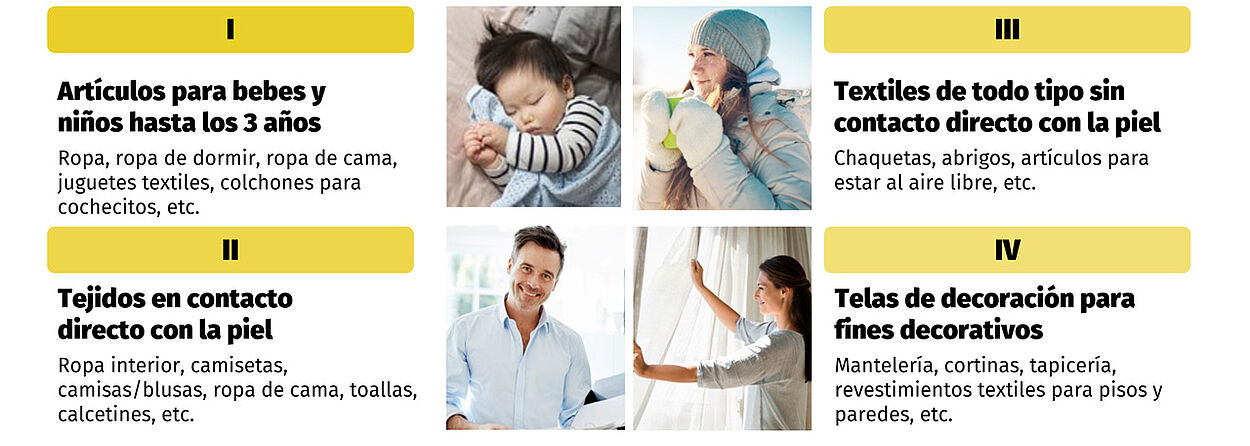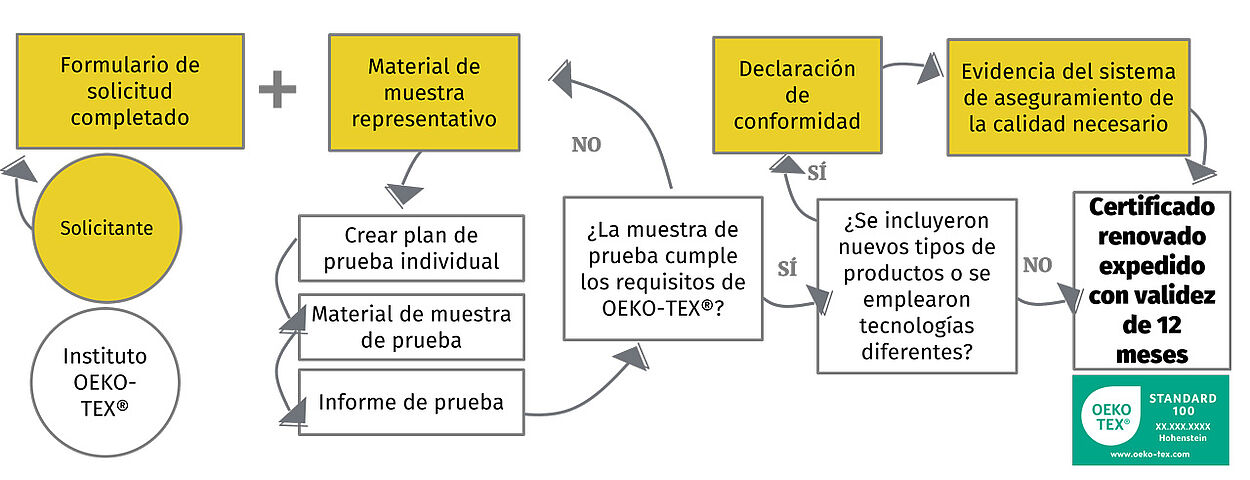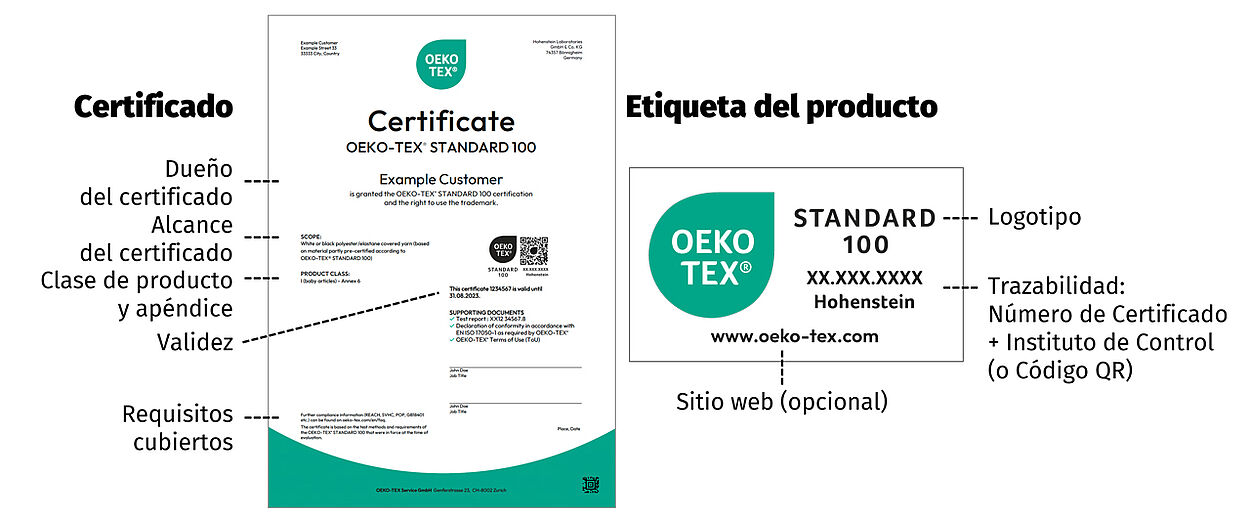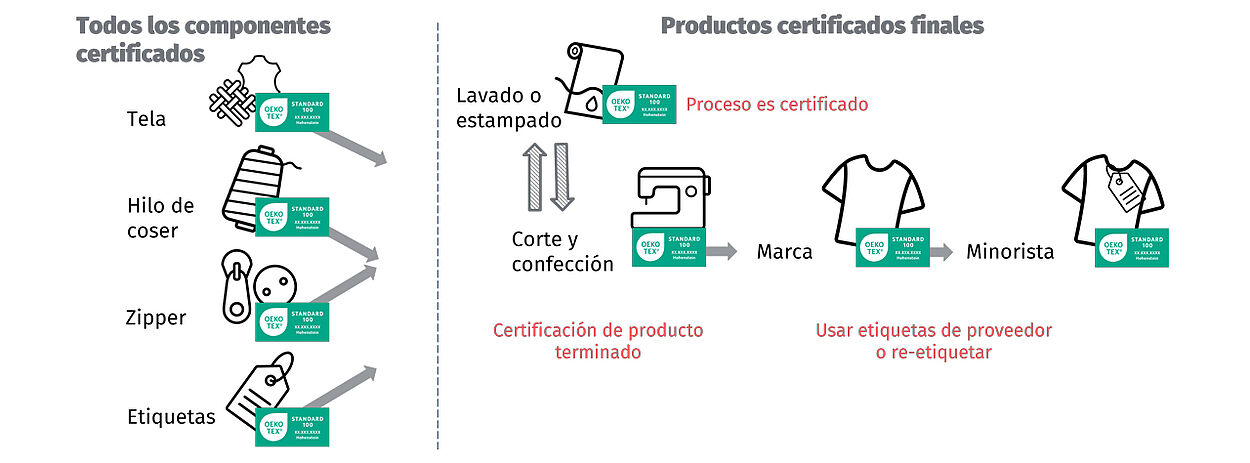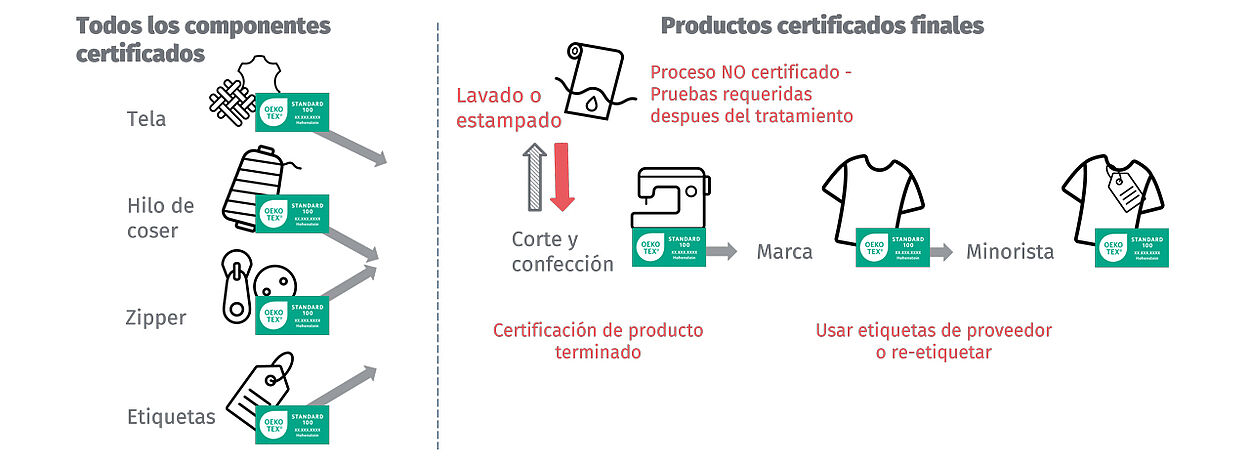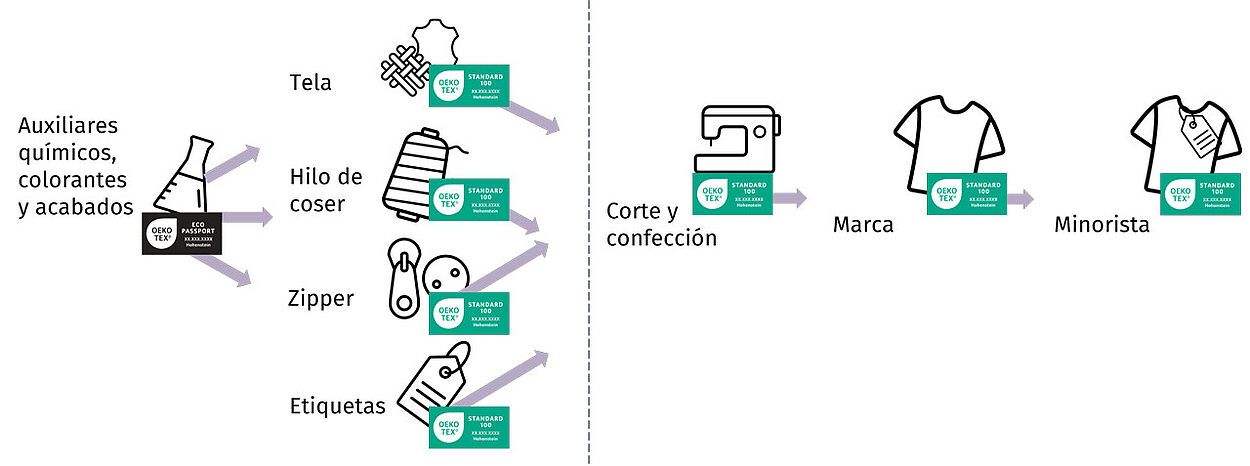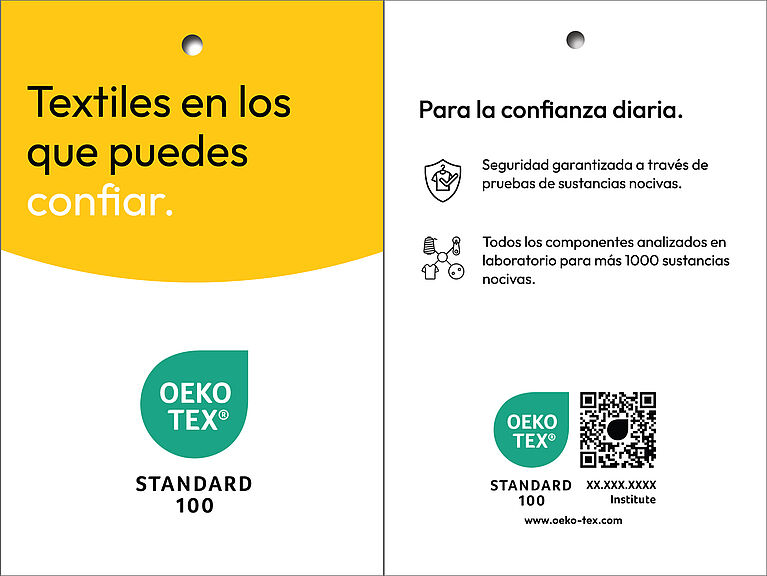¿Qué hace OEKO-TEX® STANDARD 100?
- Brinda a los consumidores y compradores una etiqueta de terceros confiable para productos no dañinos que se prueban de acuerdo con estrictos estándares globales para proteger las personas de sustancias nocivas en los textiles
- Proporciona apoyo específico a las empresas de la cadena textil en gestión de seguridad de los productos ecológico-humanos, basado en un catálogo de criterios científicos y pruebas de laboratorio neutrales
- Simplifica y acelera las relaciones con los proveedores para los fabricantes y minoristas que desean garantizar la seguridad de los productos para sus clientes
- Garantiza la conformidad legal para importadores, minoristas y fabricantes
¿Qué afirmación certifica OEKO-TEX® STANDARD 100?
La certificación OEKO-TEX® STANDARD 100 significa que un producto, material, accesorio u otro bien relacionado con textiles ha sido probado para detectar sustancias que podrían dañar la salud humana. Este estándar protege a las personas de las sustancias tóxicas que quedan en el producto.
Para hacer la declaracióm sobre un producto terminado, éste y cada uno de sus componentes/insumos debe ser probado. Esto significa que NO se permiten declaraciones de certificación de ingredientes (p. ej., "el tejido de este producto está certificado").
Aunque un producto que es más seguro para los humanos también podría ser mejor para el planeta, STANDARD 100 no es una declaración de ecosostenibilidad. La sostenibilidad se verifica a través de la etiqueta OEKO-TEX® MADE IN GREEN, de la cual STANDARD 100 es una parte importante.
¿El STANDARD 100 influye en la sostenibilidad?
OEKO-TEX® STANDARD 100 es un estándar de seguridad del producto. Sin embargo, limitar o restringir un producto químico a nivel de componente influye en la química de entrada y en las fábricas.
- La lista de sustancias restringidas STANDARD 100 ha seguido ampliándose de 100 sustancias (en 1992) a más de 1000, incluidas sustancias químicas como formaldehído, APEO, PFC y metales pesados que afectan negativamente a los humanos. Muchas de estas sustancias restringidas también impactan al planeta
- Los valores límite de STANDARD 100 (control de salida) están directamente relacionados con la certificación química OEKO-TEX® ECO PASSPORT (control de entrada), lo que incentiva el uso de productos químicos certificados, que significa que se utilizan mejores productos químicos desde el principio
- ECO PASSPORT influye entonces en los productos químicos que ingresan a las fábricas certificadas OEKO-TEX® STeP (control de procesos)
- Los límites bajos y obligatorios en productos a través de STANDARD 100 son un enfoque de sistemas importante para limitar los impactos negativos de los productos químicos en los consumidores, al tiempo que influyen en la gestión responsable de productos químicos en toda la cadena de suministro
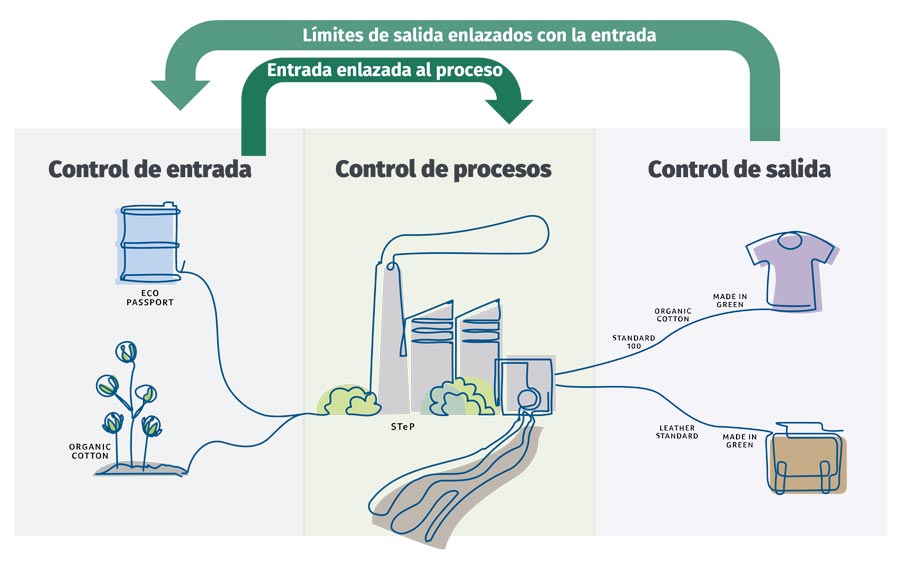
¿Qué se prueba para la certificación STANDARD 100?
El catálogo de criterios de OEKO-TEX® contiene una amplia variedad de parámetros de prueba que consideran todas las formas en que se puede absorber una sustancia (piel, boca, respiración). Los componentes centrales de STANDARD 100 (requisitos, valores límite y métodos de prueba) se basan en la ciencia. En muchos casos, los criterios de prueba y los valores límite van mucho más allá de las normas y reglamentos internacionales aplicables. La inclusión de sustancias potencialmente nocivas aún no reguladas legalmente refleja el papel pionero.
¿OEKO-TEX® STANDARD 100 demuestra el cumplimiento de las regulaciones y estándares?
Listas de sustancias y valores límite de OEKO-TEX® STANDARD 100:
- Garantiza el cumplimiento con el Apéndice XVII y el Apéndice XIV del Reglamento REACH de la UE (CE) N.º 1907/2006 y el Reglamento (UE) 2019/1021 de la UE sobre contaminantes orgánicos persistentes (POP)
- Cubre todas las sustancias relevantes para textiles y cuero de la lista de sustancias candidatas a sustancias extremadamente preocupantes (SVHC) de la Agencia Europea de Sustancias Químicas
Con la certificación OEKO-TEX®, no es necesario realizar tareas de comunicación a lo largo de la cadena de suministro con respecto a las sustancias SVHC. Sin embargo, en algunos casos excepcionales de requisitos técnicos en los que las sustancias SVHC están presentes y no se pueden evitar, esto se indica claramente en el alcance del certificado para respaldar la comunicación obligatoria. - Asegúrese de cumplir con los requisitos de plomo total de la CPSIA
Todos los laboratorios textiles asociados a OEKO-TEX® están acreditados por la CPSC (Comisión de Seguridad y Productos del Consumidor de EE. UU.). Un informe de laboratorio para la norma OEKO-TEX® STANDARD 100, clase de producto 1, sirve como evidencia de cumplimiento con respecto al contenido total de plomo (con excepción de los accesorios hechos de vidrio) en productos para niños. - Demuestre el cumplimiento de las sustancias restringidas con la norma NFPA 1970
- Garantice el cumplimiento de GB 18401
Las clases de productos OEKO-TEX® son comparables y cumplen con todos los valores límite de GB 18401. Sin embargo, GB 18401 contiene requisitos de etiquetado adicionales que no forman parte del catálogo de criterios OEKO-TEX® STANDARD 100 - Están alineados con:
- Lista de sustancias restringidas del Grupo de Gestión Internacional de RSL´s de Ropa y Calzado (AFIRM)
- MRSL de Descarga cero de productos químicos peligrosos (ZDHC)
- Otras reglamentaciones legales pertinentes y MRSL/RSL de las partes interesadas
¿Cuáles son las clases de productos STANDARD 100?
¿Cuál es la diferencia entre el Anexo 4/5 y el 6/7?
Anexo 4/5 (más común)
- Los parámetros y valores límite definidos se basan en datos científicos para proteger de forma fiable la seguridad ecológica humana. Este estándar también cumple o supera las regulaciones globales (como las REGULACIONES REACH)
Anexo 6/7
- El catálogo de criterios ampliado es para empresas centradas en la campaña Detox de Greenpeace y se requiere para todos los textiles en el estándar de prueba de Greenpeace
- Prescribe valores límite más estrictos para muchos parámetros de prueba y sustancias, no para la salud humana, sino para mejorar el desempeño ambiental en la producción de textiles para alinearse con la campaña Detox
¿OEKO-TEX® prueba y certifica para PFAS?
Los PFAS están prohibidos en todos los estándares OEKO-TEX®, incluido el STANDARD 100.
A partir del 1 de enero de 2024, se requieren pruebas de flúor total para todas las clases de productos (reemplaza el método EOF/Flúor orgánico extraíble anterior e incluye TOF). El valor límite es 100 mg/kg.
La certificación STANDARD 100 significa que el producto ha sido probado para las sustancias enumeradas. NO certificamos el producto como "libre de PFAS".
¿Cuánto tiempo es válido un certificado OEKO-TEX® STANDARD 100?
Un certificado STANDARD 100 tiene una validez de 12 meses y se puede renovar anualmente. Recomendamos iniciar el proceso de renovación hasta 3 meses antes del vencimiento para garantizar la seguridad continua del producto y un proceso fluido a lo largo de la cadena de suministro con certificación OEKO-TEX®. Muchas certificaciones posteriores dependen de componentes precertificados de proveedores.
¿Cómo se seleccionan las muestras para las pruebas OEKO-TEX® STANDARD 100?
La descripción del artículo en el certificado se basa en una selección representativa de muestras que debe cubrir todo el grupo de productos para ser certificado. Una selección de muestra incompleta puede dar lugar a una restricción del grupo de artículos certificados.
¿STANDARD 100 requiere auditorías? ¿Por qué?
Para garantizar la seguridad constante de los productos certificados, debe existir un sistema de gestión de calidad aprobado. Los auditores calificados verifican los sistemas durante las reuniones de control de calidad en el sitio. Estas reuniones ocurren dentro del primer año de la certificación y cada tres años a partir de entonces.
¿Puedo usar biocidas o ingredientes retardantes de llama?
La mayoría de las sustancias biológicamente activas/biocidas y retardantes de llama están prohibidas en productos con certificación OEKO-TEX®.
Se hacen excepciones para las sustancias en la lista de productos químicos activos OEKO-TEX®, que han sido examinadas por separado por un toxicólogo asociado de OEKO-TEX®.
¿Qué son los suplementos para artículos especiales y EPP?
Los suplementos de STANDARD 100 están relacionados con segmentos de mercado específicos y tipos de productos con requisitos específicos.
- Equipo de protección personal (EPP) y materiales para EPP - excepciones para mantener las cualidades protectoras
- Artículos especiales - para productos acabados complejos como camas, muebles, cochecitos, etc.
Comuníquese con nosotros para determinar si su producto está sujeto a un suplemento.
¿Cómo se puede utilizar la etiqueta STANDARD 100?
El certificado y la etiqueta OEKO-TEX® STANDARD 100 se otorgan solo cuando todos los componentes cumplen los criterios de prueba. Los productos terminados deben tener su propia certificación, incluso si todos los componentes individuales ya han sido certificados.
Dado que la etiqueta STANDARD 100 es una marca registrada protegida, todas las empresas que utilicen la etiqueta deben cumplir con las reglas de etiquetado. La falsificación y el uso indebido de la marca pueden ser perseguidos por las leyes penales y civiles.
Una etiqueta STANDARD 100 solo es válida si se muestran el número de prueba y el instituto de prueba responsable. Estos datos también deben corresponder al propio certificado de la empresa.
Para los compradores B2B, una etiqueta STANDARD 100 aplicada a un producto no es prueba suficiente de una prueba exitosa. Los compradores siempre deben exigir al proveedor que presente un certificado OEKO-TEX® válido. Los detalles en la etiqueta STANDARD 100 (número de prueba e institución de prueba) deben corresponder a los del certificado y el producto debe estar incluido en el alcance del certificado.
Consulte la guía de etiquetado y póngase en contacto con nosotros si tiene alguna pregunta.
¿Cuánto cuesta la certificación STANDARD 100?
Las tarifas de certificación STANDARD 100 se componen de:
- Tasa de licencia - fija - anual
- Tarifa de auditoría de la empresa - fija - 1er año, luego cada 3 años
- Tasas de examen - variables - anuales
- Las tarifas se basan en los gastos de prueba para el producto o material textil específico
- El uso de materiales de origen precertificados puede reducir significativamente las pruebas de laboratorio para el solicitante. El sistema modular utilizado en la certificación STANDARD 100 distribuye los costos de las pruebas a lo largo de la cadena de suministro
- Contáctenos para obtener una cotización basada en las pruebas requeridas y las certificaciones previas
¿Pueden las pequeñas empresas utilizar OEKO-TEX®?
¡Sí! Marcas, minoristas, fabricantes y proveedores, de todos los tamaños, utilizan el sistema OEKO-TEX®. Debido al diseño modular, el abastecimiento de componentes precertificados elimina las pruebas redundantes (costos) y hace que la certificación sea accesible para las empresas más pequeñas.
Prairie Wear, una pequeña marca, utiliza OEKO-TEX® en su cadena de suministro y marketing. Les ha ayudado a tomar mejores decisiones, generar confianza y crecer globalmente.
¿Cómo obtengo la etiqueta Climate Pledge Friendly en Amazon?
OEKO-TEX® STANDARD 100 y MADE IN GREEN son certificaciones confiables para el programa Climate Pledge Friendly en Amazon.
Para obtener la etiqueta Climate Pledge Friendly para los productos vendidos en Amazon:
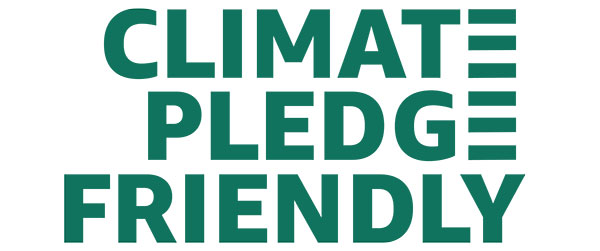
- Complete la plantilla de Climate Pledge Friendly (archivo .csv)
- Envíe los ASIN a Amazon's Vendor Central o a Amazon's Seller Central
- Una vez que se validen los ASIN certificados, Amazon reconocerá en el programa Climate Pledge Friendly (~10 días hábiles)
¿Cómo certifica OEKO-TEX® un proceso de conversión?
Un certificado de comisión OEKO-TEX® STANDARD 100 es para empresas que brindan un servicio de conversión (por ejemplo, teñido, estampado, acabado, recubrimiento, lavado, etc.), pero no producen el material en sí. El certificado de comisión de un convertidor cubre el proceso de conversión, pero no el material/producto. El material sería certificado por su proveedor.
Convertidor Certificado
Convertidor no certificado
Ejemplo: proceso de conversión certificado
Debido a que el sistema OEKO-TEX® es modular, un certificado de comisión reduce los costos de prueba para sus clientes.
¿Son rastreables los certificados OEKO-TEX®?
OEKO-TEX® se basa en un sistema modular. La certificación está disponible para cada etapa de la cadena textil y los certificados de etapas anteriores se reconocen descendentemente. Esto significa que los costos se comparten a lo largo de la cadena de suministro y se mejora la trazabilidad.
¿Existe una etiqueta colgante STANDARD 100?
Los propietarios de etiquetas pueden descargar etiquetas colgantes STANDARD 100 desde el portal myOEKO-TEX®, personalizadas con el número de etiqueta y el instituto - y disponible en varios idiomas.
¿Cómo garantiza OEKO-TEX® una calidad constante?
Además de los programas internos de garantía de calidad, la empresa certificada acepta la declaración de conformidad durante la solicitud. Este acuerdo permite a los institutos OEKO-TEX® realizar pruebas de control.
Cada año, Hohenstein realiza pruebas de control en al menos el 25% de los productos certificados. Los materiales previamente certificados se vuelven a probar durante los procesos de certificación de los productos posteriores. Muestras aleatorias de productos certificados OEKO-TEX® se compran en las tiendas y se vuelven a probar en el laboratorio. Además, auditores independientes encargados por OEKO-TEX® realizan inspecciones in situ sin previo aviso para evaluar la garantía de calidad in situ en las instalaciones.

